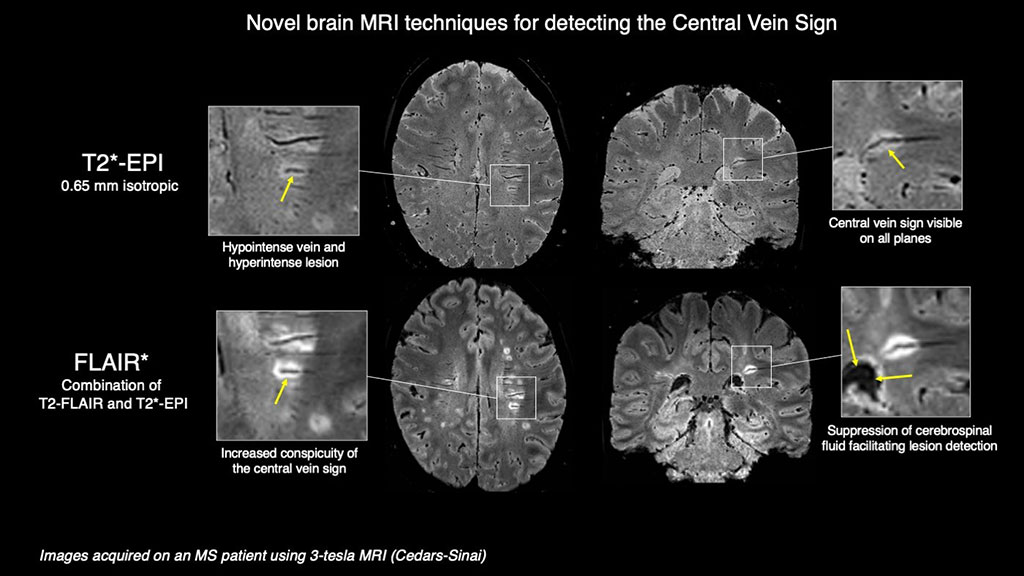Novel Brain MRI Technique Helps Identify Multiple Sclerosis Lesions
Posted on 25 Apr 2022
In patients with multiple sclerosis (MS), the immune system attacks the insulating layer that protects nerves. The disruption or loss of these layers results in lesions, which show up as white spots on MRI brain scans—the main tool for diagnosing the condition. But MS is not the only condition that can cause white spots to appear on an MRI and migraines are the most common cause of non-MS white spots on MRIs. As a result, patients who are misdiagnosed with MS are needlessly prescribed costly immune-modifying treatments that can increase risk for infection, cause organ damage and decrease the effectiveness of vaccines. Now, researchers are using advanced techniques for imaging the brain and eyes, along with new biomarkers, to present a clearer picture of MS. Their work could lead to improved diagnosis and treatment of the disease.
A team of physician and scientists in the Department of Neurology at Cedars-Sinai (Los Angeles, CA, USA) has identified biological sign called “central vein sign” that could help physicians determine whether white spots on a patient’s MRI are caused by MS or by something else, ultimately reducing misdiagnosis. MS lesions tend to form around tiny veins through which immune cells enter and attack brain tissue, so most lesions caused by MS have a vein in the middle. New MRI techniques pioneered by the researchers make central vein sign visible.

Ongoing studies at Cedars-Sinai and 10 other MS centers in North America are using the new technique to image 400 patients at risk of developing MS - the final step in scientifically validating central vein sign as a way to diagnose MS. Importantly, the new imaging technique can be used with widely available MRI scanners and performed quickly enough to fit the workflow of the typical radiology center. The team is also developing a machine learning algorithm to make evaluation of the imaging results easier for physicians. The central vein sign could also help doctors determine how well a patient is responding to treatment by confirming that any new lesions that develop are caused by MS and not something else.
The researchers are also focusing on imaging of the retina - the layer of tissue at the back of the eye - and the optic nerve that can also help improve MS diagnosis. Using a technology called optical coherence tomography (OCT), which functions like an MRI for the retina and optic nerve, the team has shown it can detect MS lesions that an MRI can miss. Optical coherence tomography captures 3D images of patients’ retinal layers, including the ganglion cell layer, which sends visual information to the brain. Retinal imaging could also help indicate how well a patient is responding to treatment. The team is continuing to study the role of OCT, along with a related technique called optical coherence tomography angiography (OCTA), as a way to understand how MS affects the blood vessels in the retina. While ocular nerve and retinal imaging is important to evaluate in MS patients, it is not yet widely available in practice. The team hopes their research will help change the standard of diagnostic care.
“Current MRI images don’t give us the whole picture, which is why we developed MRI sequences that improve image quality so that we can see very small veins, called veinules, in the brain,” said Pascal Sati, PhD, director of the Neuroimaging Program in the Department of Neurology and associate professor of Neurology at Cedars-Sinai, who pioneered the MRI technique. “We superimpose that over a conventional MRI image of the lesions so that it is clear which brain lesions have a central vein and are likely caused by MS.”
“Once the image is taken, our deep learning algorithm can analyze it very quickly and tell the clinician how many lesions show the central vein sign,” added Sati. “The number of lesions with the central vein sign can indicate whether or not the patient has MS.”
“The optic nerves are very small and difficult to image. Detecting lesions there can help us clinch an MS diagnosis, especially in patients who are relatively early on in their disease course,” said neurologist Omar Al-Louzi, MD, director of the Visual Outcomes Laboratory at Cedars-Sinai, whose research seeks to use the eye as a window to produce better outcomes for patients. “Shrinking of the ganglion cell layer often mirrors overall brain degeneration, and occurs in 70% to 80% of MS patients. This is why ganglion imaging could also help us improve diagnosis.”
Related Links:
Cedars-Sinai














